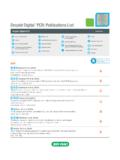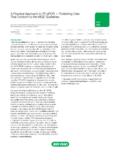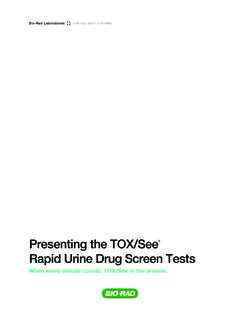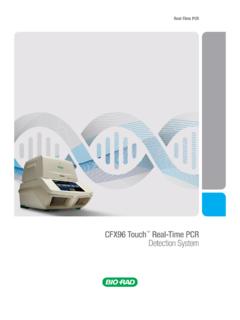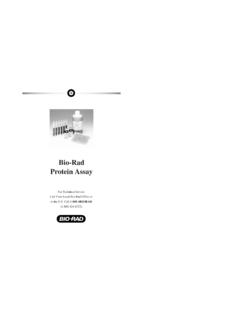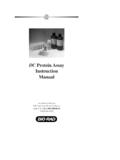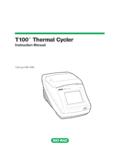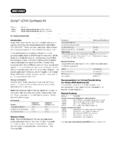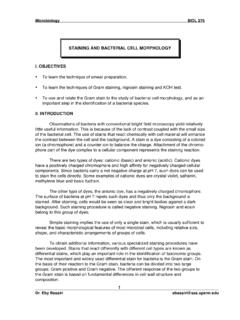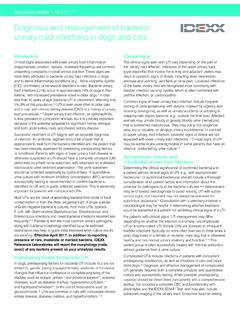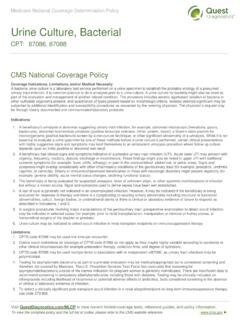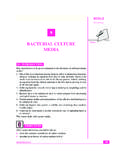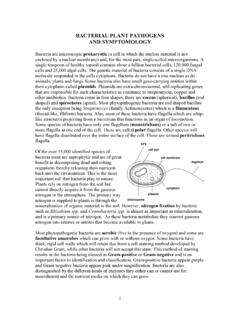Transcription of Bacterial Serotyping Guide for Salmonella
1 Ordering InformationDetection and identification of SalmonellaFood Science Immune Sera Bacterial Serotyping Guide for SalmonellaMinimizing RiskThe monitoring of veterinary diseases and quality control of industrial products are public health issues. Microbial populations which cause infection vary over time depending on manufacturing and transport conditions. Consequently, to prevent such risks, it is important to take an active role in the overall food chain monitoring process. As part of such an approach, studying bacteria from an epidemiological standpoint is essential for monitoring and anticipating dynamic changes in microbial structures. An antiserum is a high performance reagent enabling accurate identification of bacteria. It thus makes classification and evaluation of changes in such microbial populations as an identification ToolSerotyping (serological typing) is based on the long-standing observation that microorganisms from the same species can differ in the antigenic determinants expressed on the cell surface.
2 Serotyping is one of the classic tools for epidemiological study and is applied to numerous species that express different serotypes, such as: Escherichia coli, Pseudomonas aeruginosa, Salmonella species, Shigella species, Yersinia and Vibrio in SerotypingWith an extensive range of immune sera for Serotyping , Bio-Rad offers a wide range of reagents serving the needs of veterinary, food and service laboratories. The method s ease of use enables every laboratory to perform identification of Bacterial strains. Data collected promotes enhanced prevention of veterinary, human, and industrial are Gram-negative, flagellated, facultative anaerobic bacilli possessing three major antigens: H or flagellar antigen, O or somatic antigen, and Vi (capsular) antigen (possessed by only a few serovars). The different species are serotyped according to these three different antigens.
3 H (flagellar) antigen may occur in either or both of two forms, phase 1 and phase 2. There are over 1800 known serovars which current classification considers being separate species. The organisms tend to change from one phase to the other. O (somatic) antigens occur on the surface of the outer membrane and are determined by specific sugar sequences on the cell surface. Vi (capsular) antigen is a superficial antigen overlying the O antigen (additional surface antigen). It is present in a few serovars, the most important being Salmonella Typhi, but also present in Salmonella Paratyphi C and Salmonella the O, H-phase 1 and H-phase 2 are identified, the antigenic formula can be used to identify the serotype by referring to a Kauffman-White reference catalog. The formula gives the O antigen(s) first followed by the H antigen(s).
4 O antigens, Vi (when present), H antigens phase 1, H antigens phase 2 (when present). Colons separate the major antigens and commas separate the components of the antigens. Further conventions: Underlined O factor is encoded by a bacteriophage (lysogenic strain) [ ]: square bracketed factor may or may not be present (not phage-encoded) { }: curly bracketed factor never coexists with others (exclusive) ( ): parenthesis around a factor indicate weakly agglutinable factorExamplesSalmonella enterica serotype Typhimurium: 1,4,[5],12:i:1,2 This strain has the O antigen factors 1, 4, [5], and 12, the flagellar H antigen i (1st phase) and the flagellar H antigens 1 and 2 (2nd phase). Salmonella enterica serotype Lagos: 1,4,[5],12:i:1,5 This strain has the O antigen factors 1, 4, [5], and 12, the flagellar H antigen i (1st phase) and the flagellar H antigens 1 and 5 (2nd phase).
5 Salmonella enterica serotype Virchow: 6,7,14:r:1,2 This strain has the O antigen factors 6, 7 and 14; the flagellar H antigen r (1st phase) and the flagellar H antigens 1, 2 (2nd phase).For more examples, please refer to our Quick Guide (#xxx) including a table with some typical Salmonella serotypes isolated in food of Salmonella by SerotypingHow to Perform Salmonella Serotyping Serotyping is performed after identification of the species on a fresh, pure culture of Salmonella isolated on a non-selective agar medium. There are several media recommended for use, including M ller-Hinton or Nutrient Agar, TSI (Triple Sugar Iron) and/or LIA (Lysine Iron Agar) slants or TSA (Tryptic Soy Agar). Where polyvalent and monovalent antisera are available, start by testing agglutination with polyvalent sera, then with the specific monovalent sera corresponding to the mixture giving marked agglutination.
6 Agglutination should appear between 1 10 seconds. If agglutination occurs > 60 sec, the antigens can not be identified Simple ProtocolEasy Interpretation!!!!!!!! No agglutination = Agglutination NEGATIVE result POSITIVE result = After confirmation, isolate colonies on TSI slant (or recom-mended agar) for identification by antisera. It is important to use pure 1 free falling drop of antisera onto a slide for agglutination and add a pure reagents the slide in the circular motion for 30 seconds and observe for Serotyping Flowchart Test culture for auto-agglutination If positive If negative Autoagglutinating strains cannot be serotyped Test culture with Salmonella OMNI-O antiserum If negative If positive NOT Salmonella Test individual POLYVALENT Salmonella OMA, OMB, OMC antiserum (where required also OMD, OME, OMF, OMG) If negative If positive Test for the Vi Antigen (S.)
7 Typhi, S. Paratyphi, S. Dublin) If negative NOT Salmonella If positive Identify MONOVALENT Salmonella O antigen(s) If positive Test individual POLYVALENT Salmonella H antiserum (HMA, HMB, HMC, HMD, HM III, HE, H1, HL, HZ4, HG) If positive Identify MONOVALENT Salmonella H antigen(s) Phase 1 If positive Reverse in Sven Gard Agar and determine H antigen 2nd phase Phase inversion SG 1 to SG 6 Repeat the steps for 1st phase Look up the antigenic formula in a reference catalog (Kauffmann-White-Scheme) If positive for the 2nd phase Phase 2 If negative for the 2nd phase The strain has only 1 phase; Look up the antigenic formula in a reference catalog (Kauffmann-White-Scheme) How to Perform Salmonella Serotyping1. Test the culture for auto-agglutination Test the culture first in Physiological Water/Saline; strains that produce auto-agglutination cannot be serotyped.
8 In addition, all strains should be tested with the Salmonella Omni-O antiserum which contains antigens A 60 for the presumptive identification of O-agglutinable strains of Salmonellae. Agglutination of a strain of Salmonella with Omni-O antiserum indicates that the strain is O-agglutinable and can be serotyped with specific Test for the O antigens Begin by testing the isolate with polyvalent O antiserum. The majority (about 98%) of Salmonella encountered in warm-blooded animals possess an O antigen corresponding to the agglutinins contained in OMA, OMB and OMC sera. When agglutination occurs with one of these 3 groups, the isolate is positive for that group. The individual monovalent O antisera are used to identify the O antigen(s). Repeat the agglutination step by testing the isolate in each monovalent O antiserum present in the : The polyvalent O antiserum OMA shows agglutination therefore the following monovalent O antisera must be tested: O:1,2; O:4,5; O:9, O:46; O:3,10,15; O:1,3,19 When a strain does not agglutinate the OMA, OMB or OMC polyvalent sera, it is recommended to test this strain with Vi serum and the other polyvalent O sera.
9 If a Vi positive reaction is observed, the Bacterial suspension must then be heated to 100 C for 30 minutes, before repeating the test with polyvalent OMA, OMB and OMC sera and the corresponding monovalent sera to define the O , FLEXIBLE INTERACTIONI mage Lab Touch Software takes the guesswork out of imaging and puts publication-quality images at your fingertips in seconds. Acquire images with a rapid 3-step workflow. Engage a full complement of digital tools to assess, select, and export your images. 3. Test for the H Antigen Phase 1 Begin by testing the isolate with a polyvalent H antiserum (HMA HG). When agglutination occurs with one of these groups, the isolate is positive for that group. The individual monovalent H antiserum is used to identify the H antigen. Repeat the agglutination step by testing the isolate in each monovalent H antiserum present in the : The polyvalent H Antiserum HMA shows agglutination therefore the following monovalent H antisera must be tested: a; c; d; I; the first H antigen is identified, a phase inversion on the isolate must be performed to force the organism to repress its dominant H phase and grow in the second phase.
10 4. Phase Inversion Sven Gard MethodSven Gard medium is used during Serotyping of Salmonella to demonstrate the inapparent H antigen phase of biphasic Salmonella (Sven Gard method). Sven Gard agar should be used with the following Salmonella antisera: SG 1 to SG : H:1,2 antigens were identified in a culture SG6 (1,2 + 1,5 + 1,7 + z6) serum is used for phase inversion. H:r antigen is identified in a culture SG4 (r + z) antiserum is used for phase Test for the H Antigen Phase 2 A culture at the periphery of the invasion zone of the Sven Gard agar should be taken. Start testing again by using the H polyvalent antisera (HMA HG). If there is no agglutination, this serotype contains only one phase. If one of these groups shows agglutination, define the specific H phase by using the relevant H monovalent antisera.
